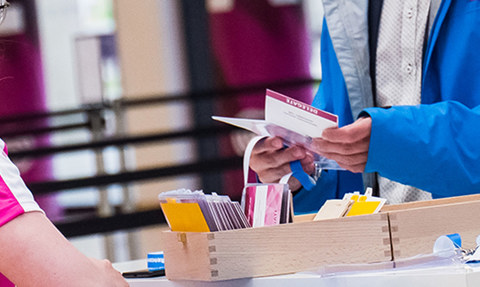Avoiding mistakes when creating name badges


Name badge printing and scanning are essential components of any successful event, whether it's a conference, trade show, or corporate gathering. These badges serve as a participant's entry ticket, identity verifier, and a means of collecting valuable data through lead retrieval.
Obviously, this is a critical component of running events. At the same time, it is a perfect opportunity to make smaller or bigger mistakes that will lead to unpleasant attendee experiences. As all event organizers know, long queues at the conference registration desks bring nothing else than anxiety and bad vibes. So, allow us to provide some ideas and tested solutions to avoid mistakes when creating name badges.
As with the event organization, you have to know first what is the sole purpose of it. Which audience does it target, and which type of content do you need for it - the same goes with event name badges. Name badges don't exist for vanity, they have many important purposes. Event organizers need to know if they need them for security reasons, networking purposes only, or everything combined together. Finding the balance between too much and not enough content is difficult, and it solely depends on the type of your business. Event planners want to become memorable and professional and have contact details at attendees' disposal if anyone asks for them.
A poorly designed badge can lead to confusion, delays, and a negative first impression for attendees. Numerous factors cause problems related to colloquial problem definition under the bad name badge design. Besides obvious misaligned graphic interpretation, flaws in the print that aren't distinct or crisp enough, or either too heavy or too light, cause glitches with event badge scanners.
Using faulty or low-quality badge printers often causes mistakes when creating name badges. Uneaven color output leads to having a discolored badge compared to other events or conferences. Bad color comes from faulty or low-quality cartridges, and in the end, causes again delays in badge scanning devices. Knowing that at some conferences, attendees have to scan their event badges several times for statistical purposes per conference stage, it might cause turmoil in the overall attendee fluctuation all over the event. Last but not least, blurred images will cause a problem for security reasons, especially as they are still a convenient identifier for event attendees when networking. It's better to invest and rent the best possible printing equipment using popular printer models such as Epson, Brother, Zebra, and Dymo, along with integration with popular Adobe and Affinity design suites if you wish to pre-create badges, which can then be sent to the print shop.
Imagine a situation when the conference is almost to begin in the early morning, while loads of attendees are anxiously waiting to pass registration desks and manage to catch up with the opening keynote. At some point, there is a problem with someone's badge, as the name on the event ticket isn't aligned with the real name. The result is another long delay while the conference staff resolves the problem, types the name properly, and prints the name badge again. Spelling errors are unprofessional, awkward, and can be embarrassing. Whether it's a job title or attendee name, it always gives the wrong impression. The only way to avoid this is to ensure plenty of people check over the order and that names that are particularly difficult to spell are ensured to be spot-on.
It has become more popular as it reduces long queues and makes the first day at any business conference memorable without the usual stress of getting on time. Professional event management software like run.events pay close attention to name badge distribution, enabling event organizers to use self-check-in kiosks for event check-in in an easy and cost-effective manner. Per the self-check-in station, event organizers only need a tablet (Android or iPad) running on the specialized app and a badge printer (such as Zebra, Brother, Dymo, or Epson). The printer needs to be connected to the tablet beforehand, using either a WiFi or Bluetooth connection. The app will recognize all the settings and badge designs, and attendees can merely approach the self-service check-in stations, scan their printed or digital tickets, perform check-in, and receive their printed badges.
Traditional lead retrieval comes with instructions on how to retrieve leads when an event or conference is over. Users are required to find a computer, log in, find events in a list, and locate reports to download. Later on, the download needs to be imported into CRM, and then the lead nurturing stage begins with the marketing and sales teams in charge. With an advanced name badge design system, event organizers avoid making mistakes that could compromise the lead retrieval process, as these name badges are designed to be used in combination with an events app, where event sponsors can quickly scan attendees' badges, take notes, and classify leads on the go. Professional event management software enables sponsors to access the leads dashboard and evaluate and categorize collected leads or export them if still necessary.
Event badge printing and badge scanning are integral to the success of any event. Avoiding common mistakes in these processes can significantly enhance the attendee experience, streamline operations, and maximize the value of lead retrieval. First hand, it always looks like an area for potential mistakes made by inexperienced people, but beware, it can happen to anyone. Therefore, it's important to remind ourselves of these little details that, in the end, become great bottlenecks causing unnecessary stress to event planners. Always take the necessary steps to optimize your badge printing and scanning processes for future event success.